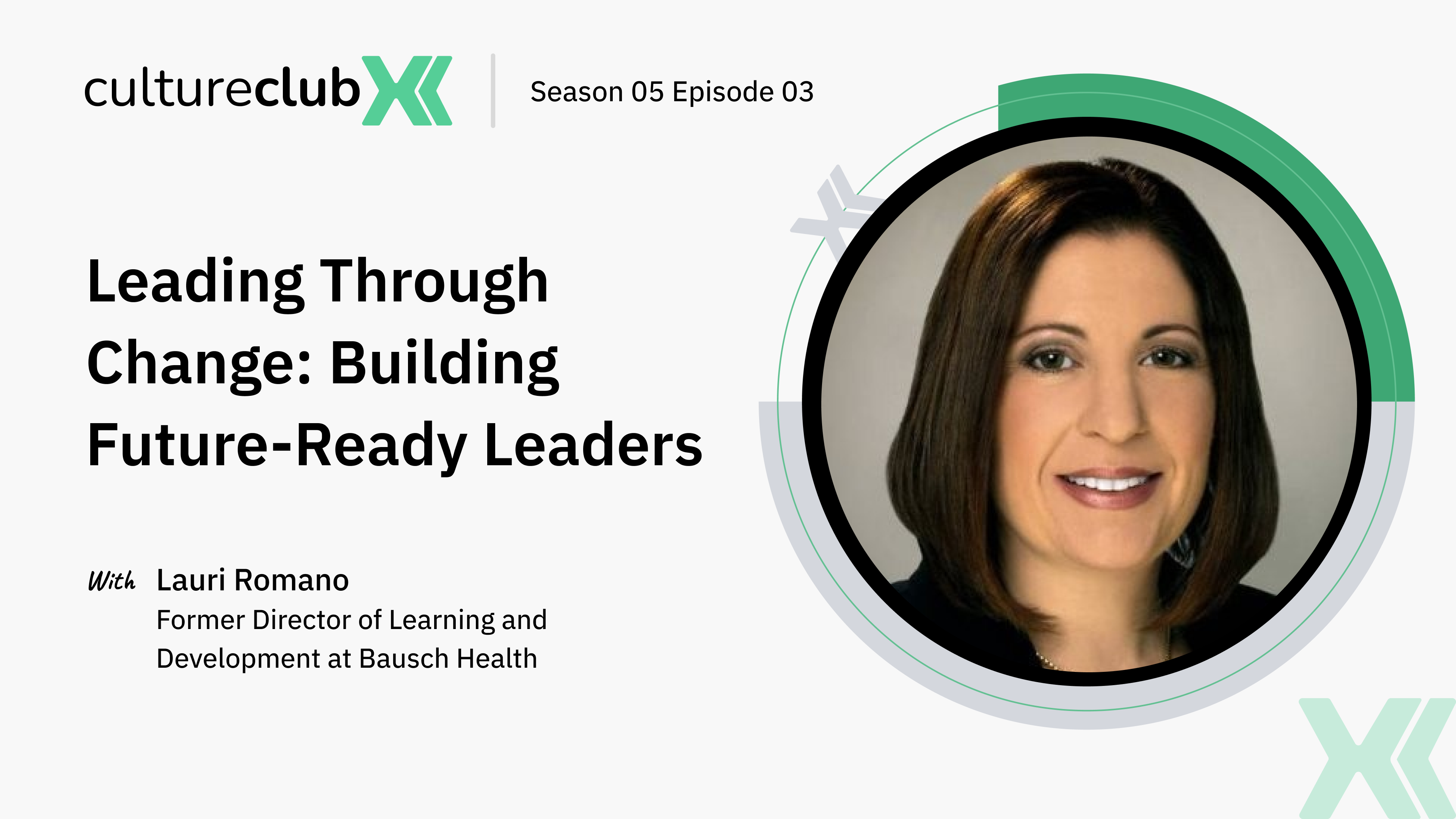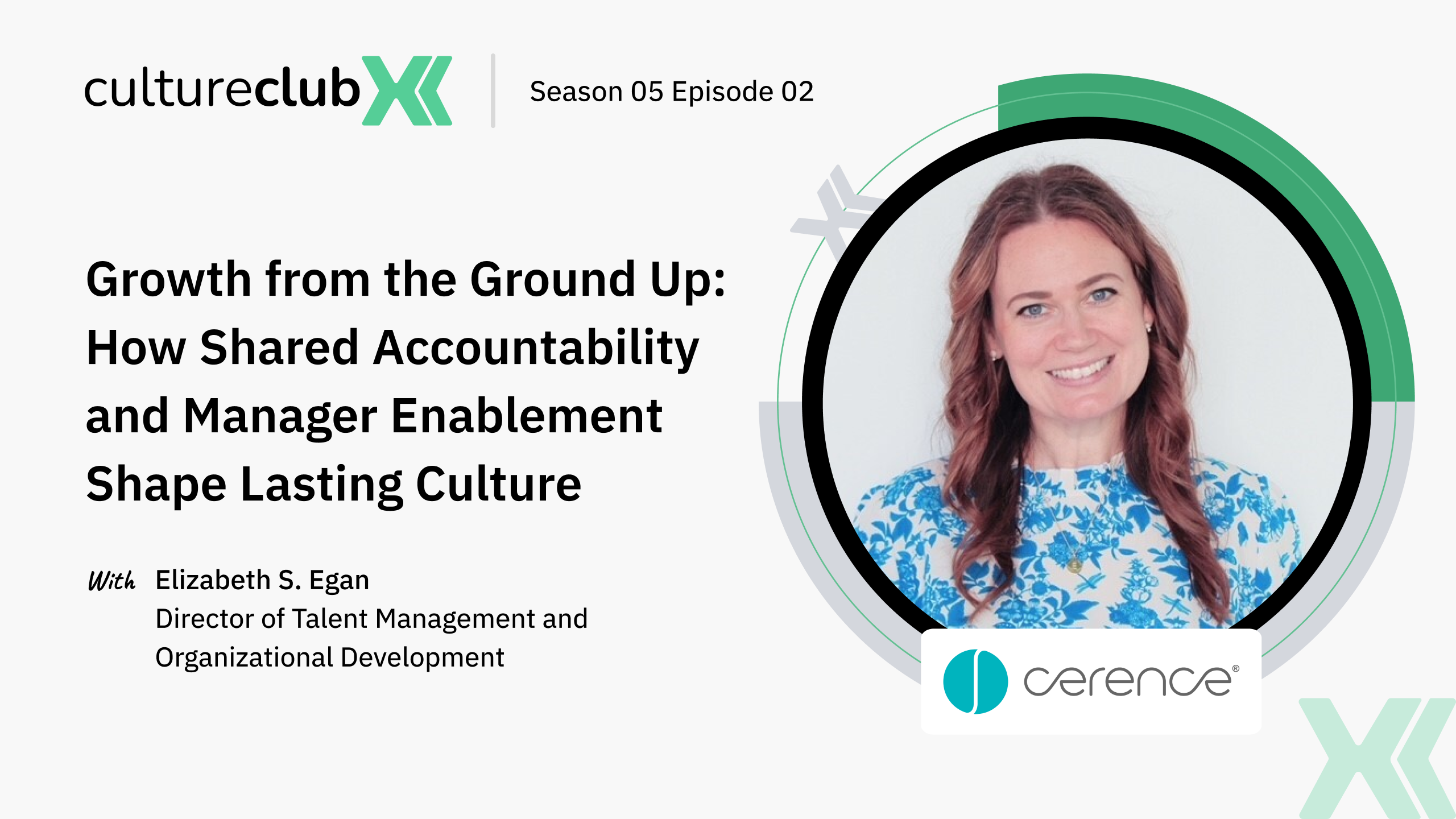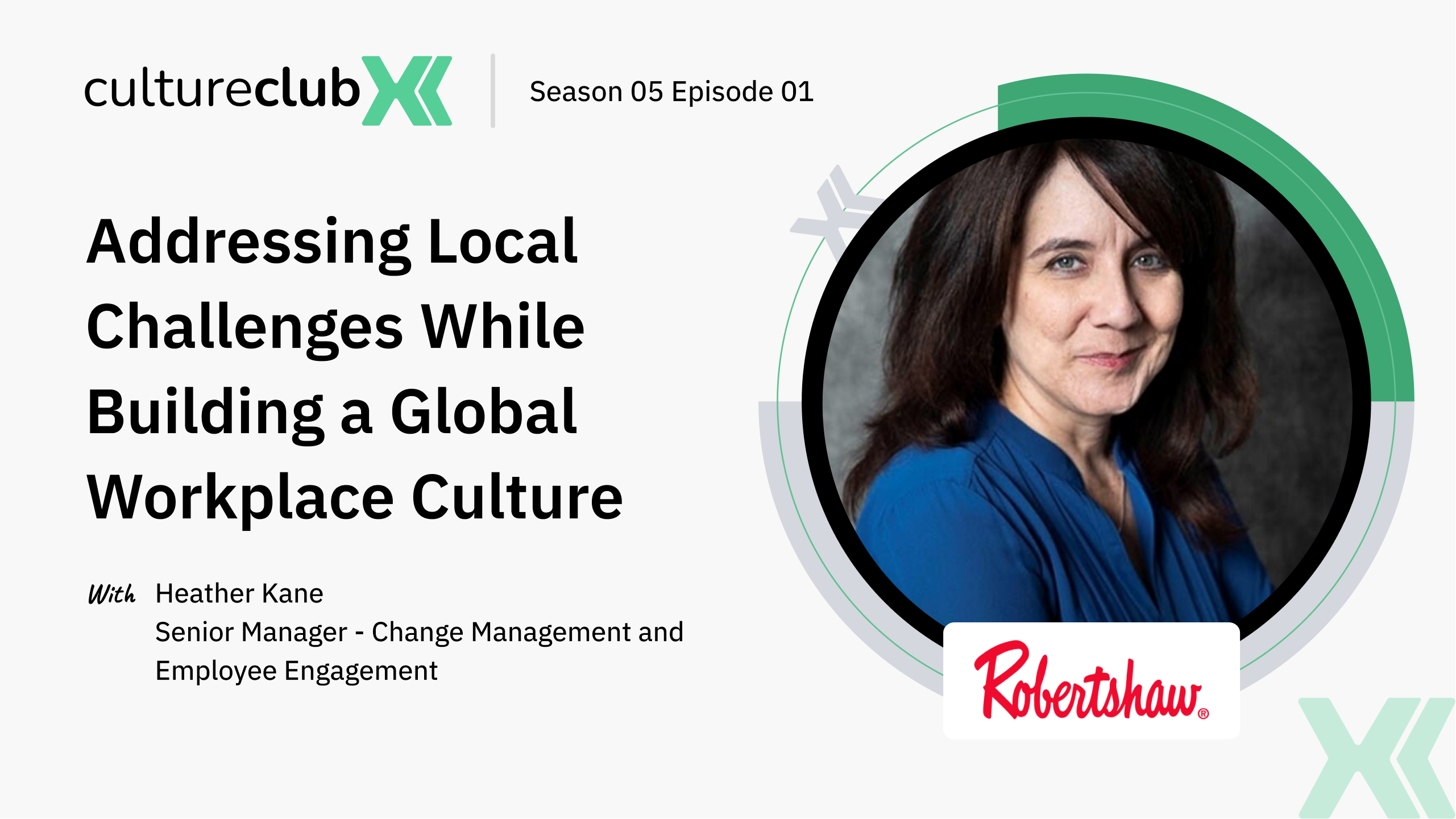S04 E01: Culture-backed onboarding – How it boosts candidate and employee experience
We are ready and excited to kick start the fourth season of CultureClub X!
In the first episode of this season of CultureClub X powered by CultureMonkey, we have with us Melinda Honcoop, Interim Head of People Ops at care.com and founder – Agile in HR, an HR Advising & Consultancy, who discusses with us the significance of culture-backed onboarding and how it boost candidate and employee experience
About Melinda
Melinda has a calling for people and creating healing workplace ecosystems. She has spent 20 years as a senior people leader and HR advisor for technology-focused companies.
She has been the Chief People Officer at TCP Software and has held multiple HR leadership roles at brands like Spiceworks-Ziff Davis, HomeAway.com, Blackbaud, and Expedia to name a few.
She co-founded the Austin Women in Agile meetup and believes in passionately guiding organizational leaders to rethink how they work to thrive.
Melinda is based in Austin, Texas and sits on the board of the non-profit – Love Justice International.
Here’s the gist of what Melinda speaks about in this video:
- How to strengthen the personalities of candidates during remote hire onboarding and how it can help them in their role and start on the right foot.
- Why onboarding isn’t just about the external hires coming in but also about the importance of reskilling and upskilling the talents. And how it can be linked to engaging your employees throughout their life cycle.
- The significance of identifying gaps during interviews to gain more knowledge in 30-60-90 days plan implementation and having one-on-one conversations can reduce hand holding.
- How can senior management help with the onboarding process for new hires to understand their part of the business and break the communication barrier, even in remote work.
Catch all this and more with Melinda Honcoop in S04 E01 of CultureClub X.
Transcript
Diana: Hi everyone, and welcome to the latest episode of CultureClub X powered by CultureMonkey. I’m your host, Diana Blass. CultureMonkey is a complete Employee Engagement platform that helps people leaders listen to their employees and enhance workplace cultures.
Diana: CultureClub X is our community initiative, where global leaders share their experiences and discuss all things company culture.
Diana: After the success of our last season. We’re excited to kick off our fourth season with Melinda Honcoop, Interim Head of People Ops at care.com and founder of Agile in HR, an HR Advising and Consultancy. Welcome, Melinda. We’re stoked to have you with us today.
Melinda: Thank you so much. It’s exciting to be here.
Diana: Well definitely excited to have you with us today to weigh on the topic. But first, let’s share a bit about your background with our viewers.
Diana: Melinda has a calling for people and creating healing workplace ecosystems. She spent 20 years as a senior people leader and HR advisor for technology-focused companies. She’s been the Chief People Officer at TCP software and has held multiple HR leadership roles at brands like Spiceworks-Ziff Davis, Homeaway.com, Blackbaud and Expedia.
Diana: She co-founded the Austin Women in Agile meetup and believes in passionately guiding organizational leaders to rethink how they work to thrive. Melinda is based in Austin, Texas and sits on the board for the non-profit Love Justice International.
Diana: When she’s not busy with people, she could be found reading, walking her dogs, traveling, or hiking. Melinda, it’s our honor to have you with us today. Welcome again, to Culture Club X’s videocast on “Culture-Backed Onboarding – How it Boosts Candidate and Employee Experience.”
Diana: Before we begin, please tell us a bit more about yourself and your organization.
Melinda: I am a true at heart people nerd and HR was a perfect profession, you know I went to University to go into social work and very much found that workplaces needed a social work lens to really understand where people start within an ecosystem and how to create healthier workplace ecosystems.
Melinda: And for me, my passion is, I believe, if we have healthier workplaces, we have a healthier society. And, you know, I love connecting and being able to look within a workplace and seeing where there is that lack of alignment, that lack of community and in order to be able to come in and find ways in which we can reconnect and rethink to build community. I can’t think of anything better than our topic today, which is onboarding in which to do that.
Melinda: It’s a very important part of the employee lifecycle but often overlooked.
Diana: Definitely and I love that you found a career path that fits so naturally with what you want to do. You know not everyone is lucky enough to find that passion right away, but we know the difference that it makes when you ultimately do find it and you’re carrying out that passion every day.
Diana: So that being said, I’m so excited to chat with you today. You’re really the perfect person to speak on this topic. So, let’s get started.
Diana: That’s really impressive, Melinda. With your professional experience so far, you seem to be the perfect person to speak on today’s topic. So, without further ado, let’s get started.
Diana: The first question, how do you think leaders should rethink remote hire onboarding effectively? So that new hires feel valued, engaged and connected equally to in-office employees?
Melinda: This is such a good question and you could spend just an hour on this one question. Often through the automation process of systems and because we get so busy, it becomes that first day experience of signing paperwork, getting to know the company a little bit. In order to rethink, it’s about what is that timeframe of onboarding and taking it from just a first day compliance activity and really, how can we create a conversation?
Melinda: A two-way conversation with the employee that doesn’t feel one-size-fits-all but is tailored to that individual—understanding who they are, their strengths, and the personality they bring.
Melinda: Being able to introduce ourselves to them, create connection before they start, complete first-day activities in advance, and make the first day about connection, expectations, role focus in the first 30-60-90 days, and alignment with manager expectations of success and impact.
Diana: And so from your experience, you know, at care.com or your startup, like what are some of those exercises that you do on a first day to get to that outcome?
Melinda: Yeah, so really trying to find first of all, being able to understand within our company, what do our new employees look like? What are those, what I like to call user personas? And what is our audience? And how are we tailoring the experience to them? And what is it that person may need that someone else may not?
Melinda: And so making sure we don’t have just a custom template that we send to everyone, that we really are getting to know people. So how do we reach out, whether it’s through a survey, questionnaire, or even insights assessment to understand communication style and working preferences, then mapping that to team assessments and sharing that in advance to foster natural conversations between manager and employee before day one.
Melinda: That builds stronger bonds and engagement. We also use this time to determine if someone is early in their career, needing basics, or if they’re an executive who needs stakeholder introductions. Preparing tailored resources and schedules in advance helps them hit the ground running.
Diana: Yeah, I love that. I like how it extends from, you know, the less personal ways through surveys and assessments but then stretching all the way to exercises they can do as a team or just YouTube videos, which I personally found to be so helpful when I have transitioned, even the types of jobs I was working. Anything I could do to prepare in advance just helped with anxiety.
Diana: So I love everything you mentioned there.
Diana: The second question, in your opinion, how critical is onboarding on the entire employee life cycle? What should be the important focus area for employers? And why is it imperative for Gen Z employees?
Melinda: I love this one because onboarding isn’t just for our external hires. If we’re looking at the entire employee lifecycle, and the moments that matter most, onboarding should also support internal promotions, role transfers, new managers, and even mergers and acquisitions. This helps create belonging and integration across all transitions, not just new hires.
Diana: Definitely, I know just from my own experience people want more communication on career path. Especially Gen Z, who aren’t as motivated by salaries but by growth and personal development.
Melinda: Exactly. Often we do a good job at external onboarding but fail to keep up those conversations after promotions. Embedding ongoing development discussions into one-on-ones ensures growth continues beyond the first role.
Diana: Hmm, and is that something that you do during evaluations, or how often do you have these conversations with employees?
Melinda: Yeah, I really try to build real-time feedback into one-on-ones, focusing not just on today’s tasks but on six- to twelve-month goals. By weaving career conversations into regular interactions, managers can align opportunities with employee passions and encourage cross-functional projects without needing bulky development plans.
Diana: Right. Yeah, I mean it seems like invaluable information and just training for a company to provide, given just the fight for talent today.
Diana: So, moving on to the third question, now you mentioned the 30-60-90. So digging further into this process. How can managers outline goals in a 30-60-90 day onboarding plan, keeping the employee skills and expectations in mind, especially for Gen Z?
Melinda: This should be mapped out before hiring. Define what a fully functional person in the role looks like, identify likely skill gaps, and create a plan to bridge them in the first 90 days. Use milestones for knowledge acquisition, application, and independence, with decreasing manager hand-holding over time. Regular check-ins ensure accountability and adjustment.
Diana: Hmm. And in regards to Gen Z, how is this process different compared to Millennials or even older generations?
Melinda: Gen Z values guided partnership and career mapping early on, beyond just the role. They want mentorship, exposure, and clarity on “what’s next.” While 30-60-90 covers role readiness, it should also include career exposure opportunities and connections across the organization.
Diana: That’s really interesting to hear. I think often younger generations are just labeled as too eager or self-serving, but as you’re saying, they actually want connection, growth, and to play a bigger role.
Melinda: Yes, exactly. Workplaces offer Gen Z something unique—mentorship, community, and diverse experiences—that they couldn’t get in a solo career. Unlocking that early builds commitment.
Diana: Hmm, definitely. Especially in light of the value of branding and how it matches with your cultural brand. Fascinating.
Diana: The next question, what part does senior management play in smooth onboarding? How can they create a diverse, inclusive, and equitable environment?
Melinda: Senior leaders are critical in onboarding, not just supervisors. Skip-level interactions break down barriers, build connection, and help new hires see how their role fits into the bigger company strategy. Beyond generic welcome videos, leaders should host two-way conversations, ideally in small groups, where employees can share insights and feel heard.
Diana: Right, and so what are some of those ways, especially in the remote world?
Melinda: Hosting intimate virtual sessions—monthly or quarterly—where leaders meet with new hires after 30-60 days works well. It allows leaders to share context and hear fresh perspectives before employees are too ingrained. It also makes senior leaders more approachable, breaking down fear of hierarchy.
Diana: Yeah, it sounds like in a way, remote culture has made it easier to set up these conversations. With meetings scheduled in calendars, barriers are broken faster.
Melinda: Yes.
Diana: How can modern people leaders rely on technology to provide an optimum onboarding experience and reduce drop-off rates?
Melinda: Technology can automate time-consuming onboarding tasks like scheduling, assessments, 30-60-90 tracking, and surveys. It can also streamline FAQs through chatbots, freeing HR to focus on strategic initiatives. This improves consistency, supports global teams with location-specific info, and ensures smoother new-hire experiences.
Diana: Wow, that’s definitely interesting. So many ways technology can help, especially chatbots. Would you say it also helps identify better candidates or improve processes?
Melinda: Absolutely. Onboarding data provides feedback loops. If ramp-up is slow, it may flag hiring mismatches or unclear expectations. That real-time insight helps adjust recruitment, refine job descriptions, and improve manager support. Data signals gaps managers may not even realize exist.
Diana: Yeah, I love that. When paired with human effort, data is invaluable.
Diana: The last question here. Do you agree that company culture has a direct impact on candidate experience? How does this affect retention, employer branding, and advocacy?
Melinda: Yes, culture is shaped by individual behaviors and interactions. Clarifying and codifying expected behaviors allows companies to hire to those values, align strengths, and avoid mismatches that lead to performance issues. Strong cultural clarity improves hiring, engagement, and retention.
Diana: And you mentioned earlier surveys and assessments. Do you use these during hiring to assess culture fit?
Melinda: Assessments can inform but should never decide. They’re best used later in the process as one of several data points. Over-reliance risks harming diversity and inclusion. Instead, focus interviews on simulating real work and observing natural behaviors with team members for culture alignment.
Diana: Yeah, definitely. Well, thank you so much for your time today.
Diana: That was such an incredible assessment, Melinda. Your perspective is so unique. Culture-based onboarding is certainly a critical factor in ensuring high productivity, engagement, and retention.
Diana: With CultureMonkey, leaders can gauge employee sentiments and provide managers with personalized, action-oriented insights effectively. Visit culturemonkey.io to see how you can improve your workplace culture today.
Diana: With that we conclude this episode of CultureClub X powered by CultureMonkey.
Diana: Thank you, Melinda. That was such a wonderful chat. Let our viewers know how they can connect with you.
Melinda: Please reach out to me on LinkedIn at “Melinda Roberts Honcoop.” I love hearing from people and do respond to most messages. Thank you so much for having me—it was such an honor to be here.
Diana: Well, that’s all we have for you in this episode of CultureClub X powered by CultureMonkey. Until next time, I’m your host, Diana, signing off.



